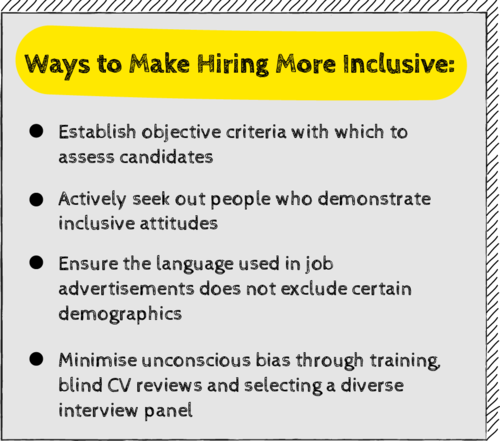.png)
First Published: 20 June, 2022
In our globalised business landscape, diversity is everywhere, and creating a diverse workforce is now vital for an organisation's success. While the multifaceted nature of New Zealand’s talent pool offers significant advantages, there is one component that is often underestimated – building an inclusive culture.
Inclusion is the key to unlocking the benefits of diversity and is vital for creating the sense of belonging that allows people to contribute their best to the team. Inclusion uses the power of differences to leverage individuals' full potential, and when combined with diverse viewpoints, can help organisations to minimise blind spots, encourage innovation, improve employee engagement and performance, promote better decision-making and increase agility and resilience.
By managing diversity effectively and building cultures of inclusion, your organisation will have the tools to maximise opportunities and achieve its goals. Here’s how.

The concepts of diversity and inclusion are often conflated, but the reality is that they are two very distinct components of a harmonious whole. As most of us are aware, diversity refers to hiring individuals of varying characteristics, including different backgrounds, genders, ethnicity, religions, ages, physical and mental disabilities, LGBTQ+ and more. Many organisations are already intentionally implementing diverse recruitment practices and are reaping benefits that stem from having a wider range of perspectives available.
Although diversity is important in itself, it is through inclusion that we can really tap into the potential advantages that drive success. Inclusion refers to whether all employees feel valued and accepted, have equal access to resources and information, are able to contribute to key business outcomes and are buoyed by inclusive policies and processes.
Inclusive organisations tend to:
Essentially, diversity is about developing teams that are more heterogeneous and contain varied perspectives, whereas inclusion means ensuring everyone has the same opportunity to thrive – and only by combining the two frameworks will we ultimately see the best outcome.
Getting the diversity and inclusion recipe right can be difficult, but there are vast rewards for doing so. Creating an inclusive work environment requires valuing diverse points of view, adopting transparent and fair internal policies and encouraging a top-down engagement to actively building inclusion into the internal culture. While there is no one-size-fits-all approach to this, research does highlight the positive impact that pursuing diversity and inclusion can have.
A report from Global Women and Deloitte on “How inclusive do New Zealand workplaces feel?” revealed that:
At its core, culture is a set of behaviours and attitudes that are driven by the people within it. Every member of an organisation contributes to the culture, but it’s up to leaders to set the tone, change policies and hold others accountable.
So, what are some of the practical strategies for creating an environment that is inclusive as well as diverse? Here are my top recommendations:
Create alignment
Invest time in ensuring all team leaders and managers are on the same page regarding what inclusion looks like for your business and the role they need to play in achieving it. Consider incorporating metrics for measuring the progress of diversity and inclusion into leadership KPIs.
Visibly champion inclusion
Connect inclusion with the organisational values to ensure it informs both internal messaging and the employer brand, and look for opportunities to promote people who are open to new ideas and viewpoints into senior roles.
Make systematic changes
Reassess the way people are evaluated and rewarded to ensure there are fair processes around performance reviews, pay, professional development and promotions.
Foster inclusive mindsets
Actively build awareness about unconscious bias and the benefits of diversity and inclusion, and consider providing formal training to educate people on the experiences of underrepresented groups.
Cultivate an atmosphere of openness
Ensure all employees feel free to be honest and share their concerns, opinions and ideas. Show them that their perspectives are important through anonymous surveys, open forum meetings, virtual suggestion boxes and opportunities to be part of decision-making.
Utilise inclusive recruitment processes
Build diversity and inclusion into the foundation of the employee lifecycle by improving the way you approach the hiring process.

Of course, it can be tough to balance diversity with finding the right cultural fit for your organisation, and it’s near impossible for us to entirely recognise and mitigate our own biases, despite our best intentions. That’s why it’s always best to have an objective third party on your side. Working with a specialist recruiter who is well-versed in inclusive hiring practices and understands how to attract talent from the broadest pool is an effective way to ensure diversity and inclusion is embedded into the core of your culture.
Want to learn more about how to create a diverse and inclusive workplace culture or need help with delivering an equitable recruitment process that gives you the greatest chance of securing top talent? Speak to our team today.
credit: Liza Viz, Beyond Recruitment
Category

Contact us if you have any suggestions on resources you would like to see more of, or if you have something you think would benefit our members.
Get in TouchSign up to receive updates on events, training and more from the MA.
